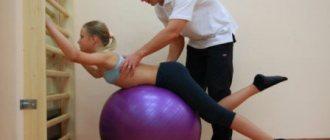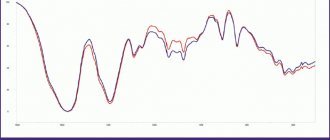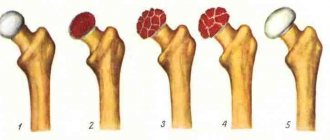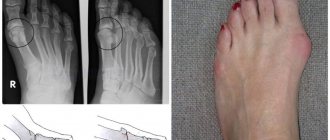The human foot has a special structure that helps absorb the load during movement. If the feet become flat, this indicates a deformation that will subsequently have a negative impact on the entire musculoskeletal system. This deformity is called flat feet. Depending on age, flat feet can be cured by performing a set of physical exercises or through surgery. But before starting any treatment for flat feet in adults, it is necessary to determine its type and stage.
Types and stages of flat feet in adults
At the moment, there are 2 types of flat feet known - longitudinal and transverse. Transverse is characterized by flattening of the foot according to the location of the toes, and longitudinal - along the length of the leg. In addition, a third type is also known - combined flatfoot. It is characterized by almost complete flattening of the foot, as a result of which the entire musculoskeletal system is actually rebuilt and deformed. If treatment for longitudinal-transverse flatfoot in adults is not started on time, an irreversible process may begin and then surgery cannot be avoided.
In addition to types, flat feet also vary depending on the degree. Today, there are 3 stages of this disease (for transverse flatfoot in medicine, stage 4 is also distinguished, but in essence its symptoms are similar to the third). From a medical point of view, this division could be called conditional, since as you move from one stage to another, the foot becomes flatter. However, the limits of deviation are not officially defined. In general, the severity of flat feet depends, rather, not on the degree of flattening of the foot, but on pain (the stronger it is, the higher the degree of the disease). However, these parameters are closely related to each other and rarely will a person feel pain with first-degree flatfoot.
As for the treatment of grade 1 and 2 flat feet in adults, some representatives of medicine believe that it is not always mandatory. We consider this statement to be incorrect. Indeed, at these stages of the disease pain is not always felt. It may seem that there is nothing wrong with this, but the consequences will make themselves felt after some time. Moreover, the load on the rest of the musculoskeletal system will increase, which will lead to deformation. But the point is that as flatfoot progresses, its treatment without surgery becomes impossible. But at the initial stage of development of flat feet, it is quite possible to get rid of it with the help of a set of physical exercises.
Diagnosis of flat feet
We list the methods that doctors use to make a diagnosis.
X-ray is one of the most accurate ways to determine the type and degree of flat feet. X-rays of both feet are taken in two projections.
Plantography is a technique that can be performed at home. A rich cream is applied to the feet, the person stands on a piece of paper with both feet, and then the print of the feet is examined. Doctors use Lugol instead of cream, which provides a more accurate print.
Friedland's technique is the measurement of the width and length of the foot using a podometric index, which allows one to determine the type and degree of flatfoot.
When should treatment for flat feet in adults begin?
As you know, there are 2 types of flat feet, based on the age at which it appeared - congenital and acquired. And if treatment of acquired flat feet in adults can give a positive effect in the initial stages of the disease without the use of surgical intervention, then with congenital flat feet everything is much more complicated. It is first discovered in childhood (every child is examined by a doctor sooner or later). Despite the fact that a child’s body has its own characteristics and, in fact, is constantly in a state of change, treatment for congenital flat feet will not have a full positive effect. Of course, to some extent it will be possible to alleviate the condition of a sick child. It is quite possible that he will not even feel any pain. But it is impossible to get rid of the disease without surgery. In turn, it is advisable to use surgical intervention for congenital flat feet closer to the age of 16. At this time, the foot is already taking on its final shape. This means that after the operation it will no longer change in its parameters. If the operation is performed earlier, then under significant loads the shape of the foot may change again and then there will be no need to talk about any treatment.
Returning to the treatment of longitudinal and transverse acquired flatfoot in adults, it should be noted that it is advisable to begin such treatment as early as possible. Even if flat feet have reached the third stage, in any case, at first it was only the first stage. It is at this time that treatment with massage and physiotherapy is most effective. But when pain occurs, treatment of flat feet in adults is only possible surgically, that is, through surgery.
Competencies
Flat feet
- Causes of the disease
- Symptoms and diagnosis
- Treatment
- Prevention
Flat feet is a structural disorder of the foot in which its arch flattens and natural shock absorption disappears. When walking, additional stress is placed on the joints of the legs and spine, which adversely affects their condition.
With flat feet, the patient may experience severe pain. This is due to overstrain of the joints, which are no longer able to provide normal active movements. The presence of the disease often leads to the development of scoliosis, arthrosis and varicose veins. To eliminate the risk of serious complications, it is important to consult a specialist in a timely manner.
Causes of the disease
Doctors identify several causes of flat feet:
- Incorrectly selected shoes - with high heels, the wrong size or too narrow;
- Overweight;
- Traumatic injuries - severe bruises, fractures or cracks;
- Hereditary predisposition;
- Past polio;
- Rachitic changes in the bones;
- Strong physical stress on the foot - standing work, professional long-distance running, jumping;
- Insufficient physical activity.
It is surprising that the development of flat feet is equally provoked by too much physical activity and too little. During active sports and standing work, a constant load is placed on the foot, which provokes its flattening.
A sedentary lifestyle can lead to underdevelopment of the ligamentous apparatus, against which the disease develops. Regular training without overexertion and excessive stress will help avoid unpleasant consequences.
Many women are interested in the question of whether constantly wearing high-heeled shoes can cause flat feet. The answer is yes. Too high heels and inappropriate instep should make a woman refuse to buy even the most beautiful shoes.
Types of flat feet
Normally, the foot has two arches - longitudinal and transverse.
Depending on which arch is affected, flat feet are divided into 3 types:
- Transverse;
- Longitudinal;
- Combined.
With combined flatfoot, both the longitudinal and transverse arches are immediately affected. The most common form of the disease is the transverse form, while longitudinal and combined forms are less common.
Based on the causes of occurrence, the disease is divided into 2 types:
- Congenital
. Occurs due to a developmental defect in the first few days of a newborn’s life. - Purchased
. Develops due to exposure to external factors.
Congenital flat feet are rare. More often the disease develops during life.
It could be:
- Paralytic (after polio);
- Rachitic (when suffering from rickets in childhood);
- Static (with insufficient physical activity);
- Traumatic (in case of damage to the bones of the foot and ankle joint).
The most common is static acquired flatfoot.
Symptoms
The disease is characterized by the following symptoms:
- Pain in the legs, which initially occurs only after walking long distances or during prolonged standing, and then even with minor physical exertion;
- Severe swelling of the ankles;
- Increasing leg length;
- With a long course - pain in the lower back.
You can determine if you have flat feet by looking at your shoes. Often the patient's shoes become too small and he has to buy a larger size. Women cannot wear high-heeled shoes - acute pain occurs. Old shoes are worn out and worn out on the inside.
Each type of flatfoot also has its own characteristic features. The longitudinal form of the disease, in addition to the listed symptoms, is characterized by the appearance of sharp pain when pressing on the middle of the foot, smoothing of the longitudinal arch, and flattening of the heel. With transverse flatfoot, symptoms are concentrated in the forefoot. Calluses often appear on the fingers. Combined flatfoot combines longitudinal and transverse features.
Degrees of flat feet
According to the severity of symptoms, the disease is divided into 3 degrees:
- Easy
. Smoothing is weakly expressed, but noticeable visually. There is practically no pain, it only occurs during heavy physical exertion. - Moderately expressed
. Flat feet are clearly visible visually. The pain becomes stronger, and with light loads, aching pain appears in the ankle and foot. The gait is noticeably disturbed - the patient is clubbed, moves heavily, and drags his feet. - Heavy
. The foot is completely deformed, flat, the arch disappears. Very severe pain is typical - it is painful for the patient to move the foot, active fast movements are almost impossible. Severe gait disturbance.
Stage 3 disease often affects not only the foot, but also the joints of the legs and spine. Possible development of arthrosis and scoliosis. In the initial stage, flat feet are a mild foot disease, but in advanced cases it leads to disruption of several parts of the musculoskeletal system. Therefore, when flat feet are detected, it is necessary to begin treating it as early as possible.
The course of longitudinal and transverse flatfoot differs in many respects. With grade 1, these differences are not so noticeable, however, grade 3 flatfoot for each form of the disease has characteristic features. With longitudinal flatfoot, the length of the leg lengthens significantly, the foot becomes deformed, and the gait changes.
Grade 3 transverse flatfoot is characterized by severe shortening of the foot. Fingers become deformed and their position changes. The thumb deviates from the rest and takes on a hammer shape. The appearance of calluses on the forefoot is typical, and severe pain is localized here.
Diagnostics
The doctor makes the diagnosis of “flat feet” based on examination data. The doctor asks the patient about the symptoms (severe pain, gait disturbance), finds out where the pain is localized, determines when signs of flat feet first appeared and what caused them.
After the interview, the doctor examines the patient’s foot and notes the flattening of the arch of the foot. After this, he is referred for plantography and podometry. The final diagnosis is confirmed by X-ray data. The picture is taken in several projections in a standing position. It can be used to detect deformation angles and determine the degree of flat feet.
Treatment of flat feet
Conservative treatment
Complete restoration of the normal arch of the foot with conservative treatment of flat feet in adults is impossible, but significant improvements can be achieved. Therapy is aimed at eliminating pain and increasing the tone of the muscles of the foot and lower leg.
To relieve pain due to flat feet, treatment is carried out with analgesic drugs that quickly and effectively relieve discomfort in the legs. Physiotherapeutic treatment can also be used.
Typically, 3 procedures are prescribed for flat feet:
- electrophoresis of the affected area;
- phonophoresis;
- treatment with magnets.
Hydromassage foot baths will also help relieve pain. They stimulate blood circulation in the foot, thereby improving nutrition of damaged tissues. Conservative therapy may include massage and therapeutic exercises - special exercises that help minimize the symptoms of flat feet in adults. The activities are aimed at strengthening the ligamentous apparatus and restoring muscle tone.
Insoles for flat feet provide a good effect at the initial stage of the disease. They help distribute the load on the foot correctly and provide additional cushioning.
It is important to understand that all methods of conservative therapy are effective only for mild flat feet.
In severe cases of the disease, bone deformations occur that cannot be removed with medications or physical therapy, only surgery. Surgical treatment
The method of surgical intervention depends on the severity of the deformity. For transverse flatfoot, one of the treatment methods is soft tissue surgery, which is a correction of the position of the ligaments and tendons of the foot.
In severe forms of deformity with deviation of the big toe (valgus deformity), surgery is performed on the bones of the foot - osteotomy. During it, the bone of the thumb is partially excised, compared with other bone formations and fixed. Due to this, the normal anatomy of the foot is restored.
The same operation is performed for deformation of the 2nd and 3rd fingers. After surgery, sutures are placed on the subcutaneous tissue and skin. The patient remains in the hospital for a day, the doctor monitors his condition and eliminates possible postoperative complications. The patient can go home the next morning.
During the postoperative period, the patient must come to the hospital for dressing changes within the time frame established by the doctor. Usually it is 5–6 days. On days 13–15, the patient's sutures are removed. For 3-6 weeks, special Baruk shoes are prescribed - you can purchase them at an orthopedic salon. After a while, you can wear regular shoes, but you should buy special insoles for them.
For the first 3–5 months after surgery, you need to limit physical activity - you cannot walk for a long time or actively engage in sports. Women should not wear shoes with heels, this can cause the opposite process.
If the talus and calcaneus are deviated, surgery is performed using an implant. This surgical treatment of flat feet is called subtalar arthroeresis. The implant, which is especially often used in the treatment of transverse flatfoot, is made of a special medical metal that remembers its shape. It fixes the foot bones in the correct position and prevents the progression of the disease.
The price of any operation depends on the severity of flat feet.
Prevention
To never encounter the last degree of flat feet, follow the recommendations:
- Choose the right shoe size - you don’t want it to rub your feet;
- Wear high-heeled shoes as little as possible;
- Massage your feet after prolonged exercise on your legs;
- Walk barefoot on sand or gravel.
Flat feet are only a seemingly simple disorder. The progression of the disease can lead to serious deformations of the musculoskeletal system. Therefore, react to symptoms in time and promptly make an appointment with a doctor. This will avoid the need for further surgical treatment of flat feet.
Types of treatment for flat feet in adults
In medicine, there are 2 main types of treatment for flat feet:
- conservative;
- operational.
The first type includes treatment without surgery. Its essence lies in selecting the most suitable shoes for the patient, prescribing him a course of medications (usually vitamins), therapeutic exercises and massage. It is necessary to resort to this option, as already noted, in the initial stages of the development of the disease. During treatment, the patient should reduce the load on the feet as much as possible. In this regard, there can be no talk of any active sports during this period. But, nevertheless, you cannot do without physical education. The essence of physical exercises, which are part of the conservative treatment of flat feet in adults, comes down to changing the shape of the foot by bending it, walking using a special orthopedic insole, etc. In addition, the patient is also prescribed a foot massage, which is carried out using specialized massagers (purchasing them is not a problem).
Today there are several treatment methods:
- orthopedic: wearing special shoes or regular shoes with orthopedic insoles;
- physiotherapeutic: electrical stimulation of weakened muscles, which leads to restoration of their tone;
- physical therapy: performing a special set of exercises aimed at strengthening muscles and ligaments, as well as normalizing “sagging” feet);
- surgical treatment: correction of the position of the bones and articular surfaces of the metatarsal bones and toes. Indicated for pain and signs of arthrosis in the joints of the foot, as well as for visible deformities of the forefoot. The surgical method is indicated only if other treatment methods have been ineffective.
The first three treatment methods are usually prescribed in a comprehensive manner. In this case, the causes of flat feet are of great importance: surgery may be indicated as the main treatment for foot deformity if flat feet have developed due to injury or improperly healed fractures of the bones of the foot.
Initially, the patient needs to undergo diagnostics, during which the individual characteristics of the disease are established and, based on this, the optimal treatment method is selected.
The Scandinavia Clinic is equipped with modern diagnostic equipment and a physiotherapeutic complex, which allows for a wide range of treatment procedures, as well as surgery to eliminate flat feet. This provides you with the most comfortable treatment, which will relieve you of this disease in a short time.
Features of surgical treatment of flat feet in adults
Surgical treatment of flat feet in adults is used only in the later stages of the disease. In such a situation, the patient may already stop walking, so there is no question of any physical exercise. Surgical treatment of flat feet in adults will require a fairly long course of rehabilitation, since the patient will need to be returned to normal life. Before performing the operation, the doctor determines whether the patient has any contraindications (most often these are individual concomitant diseases). After its completion, the patient must remain in the hospital for several days, and then must “work out” the leg at home.
Often, with combined flat feet, a bone begins to appear on the big toe. Sometimes it also appears with longitudinal flatfoot, but here everything depends on its stage. This bone cannot be removed, since it is, in fact, part of the joint. The doctor can only correct it surgically. Most often, such an operation is performed simultaneously with the treatment of flat feet, since it is an inevitable part of it. If the bone is not moved, this may lead to certain inconveniences when walking in the future. But the main problem will be that it will be extremely difficult for the patient to find suitable shoes. After all, any shoe size is built taking into account its length and width. And if there are no problems with the length, then the width at the standard size will not be enough and pain will appear in the area of the bone. Accordingly, it will be necessary to select shoes that will gradually wear out.
Based on the type of foot deformation, there are three types of flat feet:
- longitudinal (“the medial longitudinal arch sags—the depression between the heel and metatarsus smooths out or completely disappears);
- transverse (the transverse arch—the depression under the fingers—is smoothed out or completely disappears);
- combined (flat feet are present both transversely and longitudinally, but, as a rule, one of the types predominates).
One type of foot deformity, which is considered a complication of the disease, is planovalgus feet. In this condition, the feet “fall” inward - this is best seen when viewed from behind: when walking, the heel assumes a position inclined to the ground. Patients with planovalgus feet also experience severe and uneven shoe wear: the heel wears away only on the inside.
Preventive measures to prevent flat feet in adults
To avoid resorting to treatment, certain actions should be taken to prevent flat feet in adults. If nothing can be done about congenital flat feet, then it is quite possible to protect yourself from acquired ones. The main point here is the correct choice of shoes. The most important thing is that its insole should ideally follow the shape of the foot. Therefore, it is better to make insoles individually for yourself, since factory options often do not meet the standards. As for women, they should avoid wearing heels that are too high (the optimal height is no more than 4 centimeters). However, it is also necessary to select insoles when treating flat feet - in this case, special orthopedic insoles bring the greatest positive effect.
By starting to treat flat feet in the early stages, you can at least stop the development of the disease, and often get rid of it completely. Delay may not have very good consequences, so you need to monitor your body and immediately contact an orthopedist at the first appearance of the disease.
Symptoms
The first signs of the disease are mild. When walking for a long time, you may experience discomfort in your fingers, heaviness in your legs, minor pain, and swelling. Habitual shoes are uncomfortable to wear due to the expanding foot. As the arch smoothes, the signs of transverse flatfoot intensify:
- The heaviness in the legs is constant and does not depend on physical activity.
- The lower leg muscles ache, the foot and calf muscles hurt.
- Rapid leg fatigue leads to decreased performance and chronic fatigue.
- The gait becomes stiff and angular, and smoothness is lost.
- The bones on the feet are constantly irritated by the pressure of shoes. In response, the periarticular sac, which protects the big toe joint from overload, becomes inflamed.
Foot deformation is manifested by external signs (in the photo).
The size of the foot increases, the wide foot does not fit into standard shoes, the heel quickly wears out on the inside. Dry calluses and corns form on the heels and soles. The angle of deflection of the thumb increases significantly. The second and third fingers are bent, the phalanges are bent (hammer-shaped deformity). If you notice the first symptoms of transverse flatfoot, do not delay treatment. If the weight is distributed incorrectly on the foot, a pathological chain is triggered. Pain appears in the knee joints and sacral region, and pressure on the intervertebral discs increases. The risk of developing osteochondrosis, spinal hernia, and spinal curvature increases.
Gymnastics for transverse flat feet
We have conditionally divided exercise therapy for transverse flatfoot into exercises with and without a special stretching machine.
Exercises with a special stretching machine
A special stretching machine for the legs helps in the treatment and prevention of transverse flat feet. Its beneficial effect is as follows:
- reduction of deformation of the first metatarsophalangeal joints,
- slowing down the growth of “bones” on the thumbs,
- improving blood circulation and mobility of the joints of the feet,
- strengthening the muscles of the foot and ankle,
- relieving tension and fatigue in the legs.
Exercise No. 1. Place the stretcher on your big toes and bring your feet together. Keeping your heels connected, slowly point your toes out to the sides, hold this position for a few seconds and return to the starting position. Repeat the exercise 10 times.
Exercise No. 2. Place your feet parallel to each other at a short distance. Raise one foot up, without lifting your heel off the floor. Leave the other foot completely motionless. Hold for a few seconds and then return to the starting position. Repeat this exercise alternately on each leg 10 times. Increase the number of repetitions by 5 times every day
Exercise No. 3. Bring your feet together. Stretch the machine and fix your feet. Make springy movements to the sides, bringing your feet slightly closer to each other with a small amplitude. Repeat the swing several times, rest for a minute, then repeat the exercise.
Exercises for transverse flat feet without a stretching machine
Some of these exercises are performed while sitting on a chair, some while standing. Perform each exercise 15 times on each leg in 2-3 approaches.
- “Toe towards you - sock away from you”
Pull your toe toward your shin as tightly as possible and then extend it forward.
- "Let's roll the weight"
Take a weight or any other cylindrical “weight”. A bottle filled with water or sand will do. Roll the weight with your right and left legs alternately.
- "Let's roll the ball"
Alternately roll the tennis ball with your right or left foot, applying slight pressure to your foot. Instead of a tennis ball, you can use a massage ball.
- “Pull the sock towards you”
Use your fingers to either pull the toe of your foot towards you or relax it.
- "Rises on an elevated plane"
Stand on a stable stool or chair in this way: one foot is completely on the surface, the other only one-third. Spring up and down.
- "Walking from toe to heel"
Walk around the room barefoot, rolling your foot from toe to heel.











